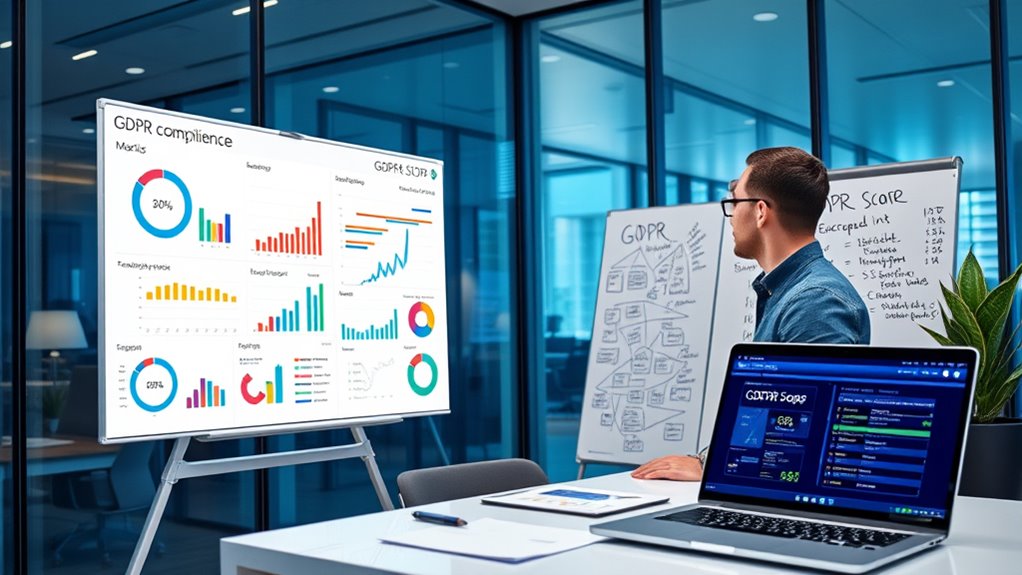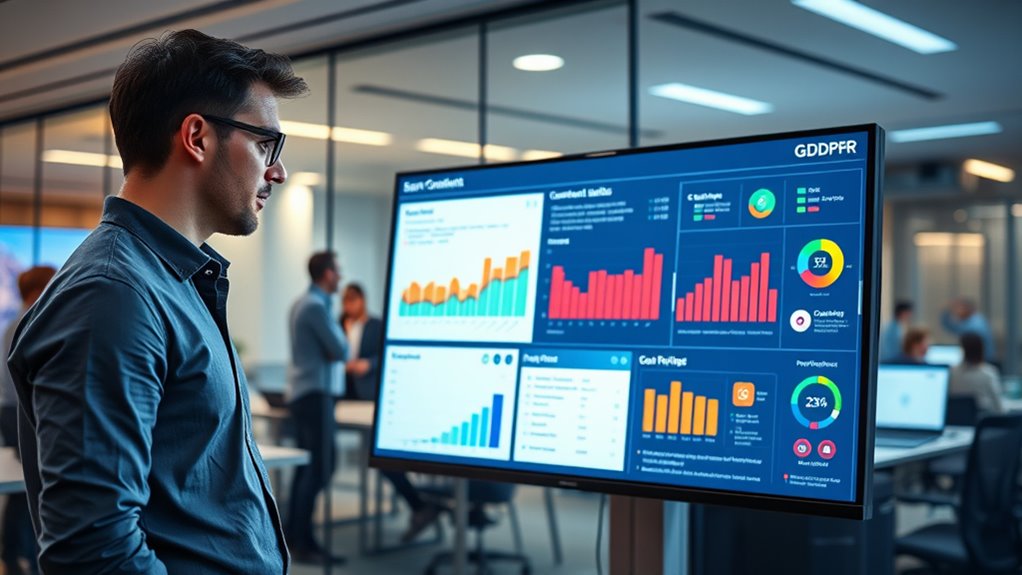As a SaaS founder in 2025, understanding GDPR basics is vital to keep user trust and stay compliant. You must obtain clear user consent, only collect necessary data, and protect it with strong security measures. Transparently inform users about data use and respond promptly to their rights requests. Building a solid data governance framework helps you manage your obligations smoothly. Keep these principles in mind, and you’ll be prepared for GDPR requirements—more detailed insights await you.
Key Takeaways
- Ensure user consent is explicit, transparent, and easily manageable for data collection and processing activities.
- Collect only necessary data, defining clear purposes and implementing data minimization practices.
- Implement strong security measures, including encryption and breach response protocols, to protect user data.
- Enable data portability, allowing users to access, transfer, and delete their personal data effortlessly.
- Maintain comprehensive documentation, privacy policies, and regular audits to demonstrate GDPR compliance.
Understanding GDPR and Its Scope for SaaS Companies

Have you ever wondered what GDPR really means for your SaaS business? It’s about more than just compliance; it’s shaping how you handle user data. GDPR emphasizes data portability, allowing users to transfer their data easily between services, giving them control. It also champions privacy by design, meaning you should embed privacy measures into your system from the start, not as an afterthought. This approach ensures your platform respects user rights and minimizes data risks. GDPR’s scope covers any SaaS company processing personal data of EU residents, regardless of where your business is based. Understanding these core principles helps you build trust, avoid fines, and create a user-centric service that prioritizes privacy and transparency. Additionally, being aware of the potential pitfalls in adopting new payment technologies can help SaaS companies better manage risks associated with payment integrations and security.
Obtaining and Managing User Consent Effectively

To comply with GDPR, you need to obtain clear and explicit user consent before collecting or processing their personal data. This means implementing transparent cookie compliance measures, such as informing users about cookies and allowing them to accept or reject non-essential ones. You should also provide easy options for users to manage their consent preferences at any time. Managing consent effectively guarantees you respect user choices and maintain trust. Additionally, you must facilitate data portability, enabling users to access and transfer their personal data seamlessly if they request it. Keep your consent requests straightforward, avoiding pre-ticked boxes or vague language. Regularly review and update your consent management processes to stay aligned with GDPR requirements, ensuring ongoing compliance and fostering user confidence. As the demand for breakfast delivery services continues to grow, ensuring transparency in data handling becomes even more vital to build customer trust.
Implementing Data Minimization and Purpose Limitation

Implementing data minimization and purpose limitation is essential to GDPR compliance and building user trust. You should collect only the data necessary for your specific purpose, avoiding excess information. Clearly define your purpose and stick to it—this is purpose specification. To further protect user privacy, consider data anonymization techniques, which remove identifiable details from datasets, reducing risks if data is compromised. Regularly review the data you hold and delete anything unnecessary. This approach not only aligns with GDPR requirements but also demonstrates your commitment to responsible data handling. Additionally, understanding how contrast ratio affects image quality can inform your decisions when optimizing visual content, ensuring a better user experience. By limiting data collection and being transparent about its use, you foster trust and reduce potential liabilities. Ultimately, these practices reinforce your SaaS platform’s reputation for respecting user privacy.
Ensuring Data Security and Handling Breach Notifications

Building on your efforts to limit data collection and specify its purpose, protecting that data through robust security measures becomes the next step. Implement strong encryption strategies to safeguard data both at rest and in transit. Regularly conduct vendor assessments to ensure your third-party partners follow GDPR-compliant security practices. Establish clear protocols for breach detection, containment, and reporting, aiming to notify authorities within 72 hours of discovering a breach. Document all security measures and breach responses meticulously. Training your team on data security awareness is equally vital. Remember, proactive security reduces the risk of breaches and demonstrates your commitment to data protection, helping you maintain trust and comply with GDPR requirements effectively. Incorporating cybersecurity vulnerabilities into your risk management plan can further enhance your readiness against emerging threats.
Upholding Data Subject Rights and Transparency

Ensuring you uphold data subject rights and maintain transparency is essential for building trust and complying with GDPR in 2025. You must clearly inform users about how their data is used through transparent privacy policies. When a user requests access, data correction, or deletion, respond promptly and efficiently. You should also facilitate data portability, allowing users to export their data easily. Here’s a quick overview:
| Data Subject Rights | Your Responsibilities |
|---|---|
| Access & Rectification | Provide easy mechanisms for data updates. |
| Erasure & Restriction | Respect deletion requests and restrictions. |
| Data Portability | Enable users to transfer their data seamlessly. |
| Transparency | Keep privacy policies clear and up-to-date. |
And adopting standardized data formats can help streamline compliance and improve user experience.
Building a GDPR-Compliant Data Governance Framework

To achieve GDPR compliance, you need a robust data governance framework that clearly defines how your organization manages, protects, and documents personal data. This framework should incorporate processes for data anonymization techniques to reduce risks, especially when handling sensitive information. It must also address cross-border data transfer compliance requirements, ensuring data moves legally between jurisdictions. Establish clear policies for data collection, storage, access, and deletion. Regular audits help verify compliance, while training staff ensures everyone understands their responsibilities. Maintain detailed records of processing activities and data flows to prove accountability. Additionally, implementing dynamic communication exercises can foster a culture of transparency and collaboration within your team. By implementing these components, you create a resilient structure that supports data privacy and GDPR adherence.
Frequently Asked Questions
How Does GDPR Impact Saas Pricing Models in 2025?
You’ll find GDPR influences your SaaS pricing models by emphasizing data minimization and data portability. You might need to offer tiered plans with limited data collection or enhanced options for users who want full data control. This means adjusting your pricing to reflect compliance efforts, ensuring users can easily transfer their data if they choose to leave. These changes help build trust and meet legal requirements without sacrificing your revenue streams.
What Are the Penalties for Non-Compliance Beyond Fines?
Imagine a storm cloud gathering overhead—your reputation on the line. Beyond fines, non-compliance exposes you to data breaches and reputational damage that can tarnish your brand for years. Customers lose trust, partnerships falter, and recovery becomes difficult. You might face lawsuits or regulatory actions that threaten your business’s future. Staying compliant isn’t just about avoiding penalties; it’s about safeguarding your integrity and ensuring long-term success.
How Can Saas Startups Build GDPR Compliance Into Product Design?
To build GDPR compliance into your product design, start with user onboarding by clearly explaining data collection and obtaining explicit consent. Incorporate data minimization principles by only collecting essential information and limiting access. Use privacy-by-design practices, like secure data storage and easy options for users to update or delete their data. These steps help guarantee your SaaS product aligns with GDPR, reducing risks and building trust with your users.
Are There Specific GDPR Considerations for Saas Operating Across Multiple Countries?
Imagine your SaaS operates in both France and Brazil. You must handle cross border data carefully, respecting each country’s data laws. Localized compliance is vital; for example, you might need to adapt your privacy policies or implement data residency solutions to meet regional regulations. Ensuring GDPR considerations for cross border data transfer helps protect user data and avoids legal penalties, making your global expansion smoother and more secure.
How Will Evolving AI Technologies Affect GDPR Compliance Requirements?
As AI technologies evolve, you’ll need to stay ahead of AI regulation changes to guarantee GDPR compliance. These advancements may introduce new data processing risks, making data sovereignty even more critical. You should regularly review your data handling practices, adapt to emerging AI-related rules, and ensure transparency. By doing so, you protect user data and maintain compliance while leveraging AI’s benefits for your SaaS platform.
Conclusion
Navigating GDPR is like steering a ship through busy waters—you need to stay alert, follow the rules, and prioritize your users’ trust. By understanding its scope, managing consent, and ensuring data security, you’ll build a solid foundation for your SaaS business in 2025. Stay proactive, transparent, and committed to data privacy, and you’ll not only avoid fines but also earn your users’ loyalty in a competitive landscape.









